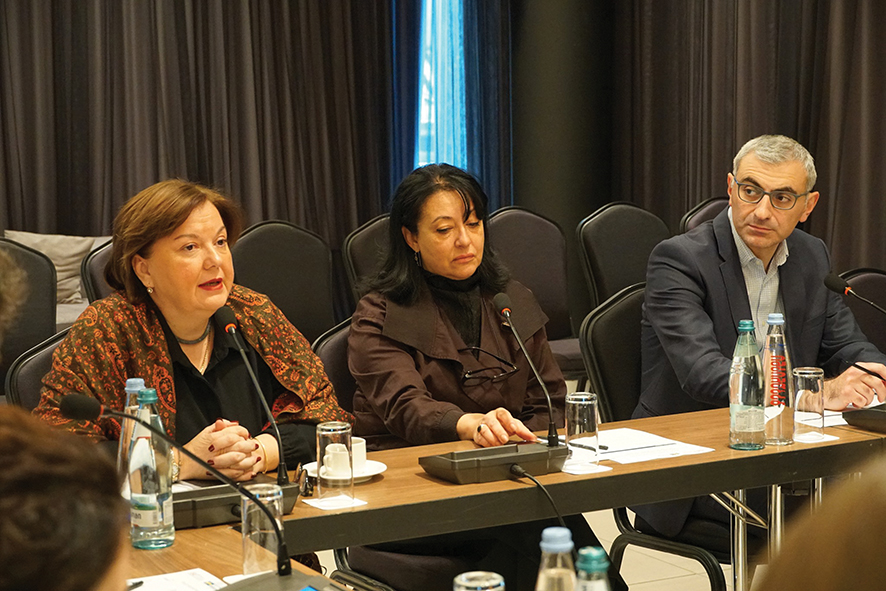A Computable General Equilibrium Model for Analyzing Free Trade Agreements in Georgia
The International School of Economics at Tbilisi State University (ISET) Policy Institute has developed a computable general equilibrium (CGE) model to analyze the potential impact of new free trade agreements (FTA) in Georgia.
Focus on Sustainable Development Goals (SDGs)
- Goal 8: Decent Work and Economic Growth
- Goal 9: Industry, Innovation, and Infrastructure
- Goal 10: Reduced Inequalities
- Goal 17: Partnerships for the Goals
According to Giorgi Papava, lead economist and lecturer at ISET, the CGE model focuses on three countries for potential FTAs: India, South Korea, and the United States. Papava discussed the benefits of the model during a roundtable and highlighted its ability to analyze economic changes in various sectors, including value output, import/export levels, household income, and tax implications.
During the roundtable, David Tarr, a former lead economist and ISET board member, explained that the CGE model would be funded by the World Bank, similar to its implementation in other countries such as Russia, Ukraine, and Kazakhstan. Tarr emphasized the importance of such a system in raising public awareness and addressing key issues. The model focuses on integration elements and provides estimates on the sectors that would benefit or suffer the most within Georgia.
The FTA with the US is expected to result in a 0.59% welfare increase gain, a 0.13% welfare increase gain with India, and a 0.10% welfare increase gain with Korea.
The CGE model has already been developed to analyze the current situation in Georgia. However, experts suggest that if Georgia were to be accepted under European Union regulations, additional impacts on the CGE model would arise. Acceptance would require analyzing additional data and extensions, including Common External Tariff (CET), Emissions Trading System (ETS), migration, harmonization, government procurement, and elimination of antidumping actions between Georgia and the EU.
Papava explained that the choice of countries for the FTAs was determined after the model was developed. India and South Korea were already being considered, but the United States was added due to high-level discussions. Papava mentioned aligning FTA policies with the EU, as demonstrated by Azerbaijan and Turkey. He clarified that there is currently no FTA with the US, and progress in that direction seems unlikely.

During the roundtable, data on imports, exports, and Foreign Direct Investment (FDI) inflow between Georgia and the three countries were compared. Papava presented potential policy scenarios with each country and their expected outcomes.
“If we sign three FTAs, in the long run, we’d expect the trade balance to improve,” said Papava. The CGE model predicts an overall 0.82% increase in welfare gains from all three FTAs. The Services sector is expected to experience the largest increase, specifically a 0.31% increase from Georgia’s side. The FTA with the US is projected to result in a 0.59% welfare increase gain, a 0.13% welfare increase gain with India, and a 0.10% welfare increase gain with Korea.
The largest positive impact on output by sectors would be in refined petroleum products, textile and clothing, and metal manufacturing.
Papava highlighted that the three FTAs would lead to a 0.25% increase in Georgia’s real gross domestic product (GDP). Services are expected to be the largest sector with an increase in almost every FTA scenario. The CGE model will assess the macroeconomic impact of the FTAs on Georgia, including aggregated impact in real terms, factor income adjustments, and fiscal impacts.
The model indicates a total 0.53% increase in exports and a total 0.34% increase in imports from the three countries involved in the FTAs. Papava also noted that the sectors with the largest positive impact on output would be refined petroleum products, textile and clothing, and metal manufacturing.
“The findings provide valuable insights for policymakers considering trade reforms, emphasizing the importance of deep preferential integration with trading partners. The reduction of non-tariff barriers for goods and the alleviation of barriers against FDI in Georgia are identified as major factors contributing significantly to improvements in welfare gains,” stated ISET on its website.
Currently, there are no formal requests or agreements in place, so Papava and other ISET representatives are looking forward to further discussions on this topic.
Tamar Sulukhia, director of the ISET Policy Institute, and Veronika Movchan, from the Institute for Economic Research and Policy Consulting, also spoke at the roundtable. Movchan discussed Ukraine’s CGE model, which includes 45 sectors and analyzes trade barriers, such as technical barriers to trade in goods, time in trade costs, and barriers in trade in services.
“We hope this is just the beginning of implementing this model for the benefit of the country,” said Sulukhia.
By Shelbi R. Ankiewicz
SDGs, Targets, and Indicators in the Article
1. Which SDGs are addressed or connected to the issues highlighted in the article?
- SDG 8: Decent Work and Economic Growth
- SDG 9: Industry, Innovation, and Infrastructure
- SDG 17: Partnerships for the Goals
2. What specific targets under those SDGs can be identified based on the article’s content?
- SDG 8.1: Sustain per capita economic growth in accordance with national circumstances and, in particular, at least 7 percent gross domestic product growth per annum in the least developed countries
- SDG 8.2: Achieve higher levels of economic productivity through diversification, technological upgrading, and innovation, including through a focus on high-value added and labor-intensive sectors
- SDG 9.1: Develop quality, reliable, sustainable, and resilient infrastructure, including regional and transborder infrastructure, to support economic development and human well-being, with a focus on affordable and equitable access for all
- SDG 9.3: Increase the access of small-scale industrial and other enterprises, in particular in developing countries, to financial services, including affordable credit, and their integration into value chains and markets
- SDG 17.16: Enhance the global partnership for sustainable development, complemented by multi-stakeholder partnerships that mobilize and share knowledge, expertise, technology, and financial resources
3. Are there any indicators mentioned or implied in the article that can be used to measure progress towards the identified targets?
- Change in value output of each sector
- Change in import/exports
- Change in real household income
- Impact on various taxes
- Foreign Direct Investment (FDI) inflow
- Trade balance
- Macroeconomic impact for Georgia
- Factor income real term
- Fiscal impacts
Table: SDGs, Targets, and Indicators
| SDGs | Targets | Indicators |
|---|---|---|
| SDG 8: Decent Work and Economic Growth | Sustain per capita economic growth in accordance with national circumstances and, in particular, at least 7 percent gross domestic product growth per annum in the least developed countries | Change in value output of each sector |
| SDG 9: Industry, Innovation, and Infrastructure | Achieve higher levels of economic productivity through diversification, technological upgrading, and innovation, including through a focus on high-value added and labor-intensive sectors | Change in import/exports |
| Develop quality, reliable, sustainable, and resilient infrastructure, including regional and transborder infrastructure, to support economic development and human well-being, with a focus on affordable and equitable access for all | Foreign Direct Investment (FDI) inflow | |
| SDG 17: Partnerships for the Goals | Enhance the global partnership for sustainable development, complemented by multi-stakeholder partnerships that mobilize and share knowledge, expertise, technology, and financial resources | Trade balance, Macroeconomic impact for Georgia, Factor income real term, Fiscal impacts |
Behold! This splendid article springs forth from the wellspring of knowledge, shaped by a wondrous proprietary AI technology that delved into a vast ocean of data, illuminating the path towards the Sustainable Development Goals. Remember that all rights are reserved by SDG Investors LLC, empowering us to champion progress together.
Source: georgiatoday.ge

Join us, as fellow seekers of change, on a transformative journey at https://sdgtalks.ai/welcome, where you can become a member and actively contribute to shaping a brighter future.






